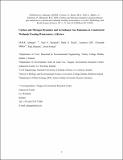| dc.contributor.author | Healy, Mark G. | |
| dc.date.accessioned | 2016-02-17T11:43:35Z | |
| dc.date.available | 2016-02-17T11:43:35Z | |
| dc.date.issued | 2016-02-17 | |
| dc.identifier.citation | Jahangir, M.M.R., Fenton, O., Healy, M.G., Gill, L., Muller, C., Johnston, P., Richards, K.G. 2016. Carbon and nitrogen dynamics and greenhouse gas emissions in constructed wetlands treating wastewaters: a review. Hydrology and Earth System Sciences 20: 1 -15. | |
| dc.identifier.issn | 1607-7938 | |
| dc.identifier.uri | http://hdl.handle.net/10379/5563 | |
| dc.description.abstract | The removal efficiency of carbon (C) and nitrogen (N) in constructed wetlands (CWs) is very inconsistent and frequently does not reveal whether the removal processes are due to physical attenuation or whether the different species have been transformed to other reactive forms. This paper aims to address this knowledge gap by reviewing the biogeochemical dynamics and fate of C and N in CWs and their potential impact on the environment, and by presenting novel ways in which these knowledge gaps may be eliminated. Nutrient removals in CWs vary with the type of CW, vegetation, climate, season, geographical region and management practices. Horizontal flow CWs tend to have good nitrate (NO3-) removal, as they provide good conditions for denitrification, but cannot remove ammonium (NH4+) due to limited ability to nitrify NH4+. Vertical flow CWs have good NH4+ removals, but their denitrification ability is low. Surface flow CWs decrease nitrous oxide (N2O) emissions but increase methane (CH4) emissions; subsurface flow CWs increase N2O and carbon dioxide (CO2) emissions, but decrease CH4 emissions. Mixed species of vegetation perform better than monocultures in increasing C and N removal and decreasing GHG emissions, but empirical evidence is still scarce. Lower hydraulic loadings with higher hydraulic retention times enhance nutrient removal, but more empirical evidence is required to determine an optimum design. A conceptual model highlighting the current state of knowledge is presented and experimental work that should be undertaken to address knowledge gaps across CW, vegetation and wastewater types, hydraulic loading rates and regimes, and retention times, is suggested. We recommend that further research on process-based C and N removal and on the balancing of end products into reactive and benign forms is critical to the assessment of the environmental performance of CWs. | en_IE |
| dc.format | application/pdf | en_IE |
| dc.language.iso | en | en_IE |
| dc.relation.ispartof | Hydrology And Earth System Sciences | en |
| dc.rights | Attribution-NonCommercial-NoDerivs 3.0 Ireland | |
| dc.rights.uri | https://creativecommons.org/licenses/by-nc-nd/3.0/ie/ | |
| dc.subject | Wetlands | en_IE |
| dc.subject | Nitrogen | en_IE |
| dc.subject | Carbon | en_IE |
| dc.subject | Greenhouse gas emissions | en_IE |
| dc.title | Carbon and nitrogen dynamics and greenhouse gas emissions in constructed wetlands treating wastewaters: a review | en_IE |
| dc.type | Article | en_IE |
| dc.date.updated | 2016-01-12T09:36:33Z | |
| dc.identifier.doi | 10.5194/hess-20-1-2016 | |
| dc.local.publishedsource | http://www.hydrol-earth-syst-sci.net/20/1/2016/ | en_IE |
| dc.description.peer-reviewed | peer-reviewed | |
| dc.contributor.funder | |~|6201984|~| | |
| dc.internal.rssid | 10186043 | |
| dc.local.contact | Mark Healy, Room Eng-1038, Civil Engineering, Col Of Engineering & Informatics, Nui Galway. 5364 Email: mark.healy@nuigalway.ie | |
| dc.local.copyrightchecked | Yes | |
| nui.item.downloads | 494 | |


